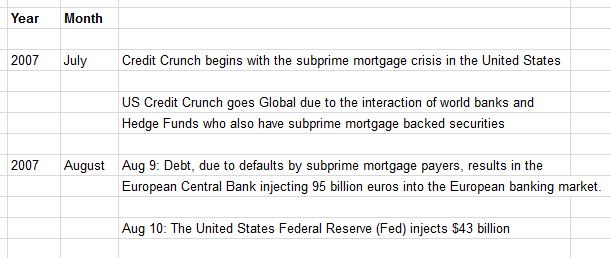Ten years ago, I was invited by the brilliant monetary theorist, Professor Antal E. Fekete, to give a talk at his Gold Standard University held August 15-31, 2007 in Szombathly, Hungary; and while there, I and others watched intently as a global credit crunch swept through world markets.
2007 / 2008 Credit Crunch Timeline of Events

The effects of the “credit crunch”, when banking companies stopped lending to each other resulting in bankrupt or acquired banks, were so serious that the Bank of England, the European Central Bank and the United States Federal Reserve had to provide ‘bail out’ packages in order to make substantial injections of capital into financial markets. (source)
In August 2007, those of us gathered in Hungary were watching history, a history that has not yet run its course. The August 2007 global credit contraction was a signal that something was wrong. Fatally wounded by the removal of gold from the international monetary system in 1971, the wheels of the bankers’ powerful juggernaut of credit and debt were beginning to come off.
In 2008, the worst financial crisis since the 1930s occurred, resulting in the bankruptcy and collapse of Wall Street banks and were it not for extreme measures of zero percent interest rates and unprecedented central bank monetary triage, the cataclysmic economic collapse I had predicted in my book, Time of the Vulture (2007), would have happened.
Instead, the bankers’ day of reckoning was delayed. Credit and debt economies were granted a temporary reprieve until the day when an even more severe economic crisis would prick the bankers’ senescent but still growing bubble of unpayable debt, a bubble that is now about to pop.
Capitalism, the bankers’ three hundred year-old ponzi-scheme, is a balancing act between the bankers’ credit and everyone else’s debt. In its optimal state, credit creates sufficient growth to pay society’s constantly compounding debts. When unable to do so, debt is paid by borrowing against future growth and in capitalism’s endgame, aggregate debt exponentially expands until it can no longer be repaid except by exponentially depreciating paper money. – DRSchoon, How It Will End, March 2014














Leave A Comment